Avatar: The Last Airbender for Cube
As I’ve done in my cube reviews, this cube review focuses more on ‘high power’ cubes than thematic ones. I’ve traditionally used a more high-powered, generalist perspective for cube card evaluation, allowing designers to adjust as needed for their specific environments. Although I test cards in my own cube, I don’t just use that as a basis of evaluation, as someone who works on the Magic Online Vintage Cube list, is familiar with cubes across the power level spectrum and with the recent availability of the Powered Cube on Magic Arena, I know how important it is to keep various environments in mind.
As I’ve done for years, my method of testing new cards by seeding them into weekly cube drafts has given me valuable real-world experience. This approach has helped identify cards like Ouroboroid and Cori-Steel Cutter that flew under the collective radar. I’ve included my review metrics at the bottom of the article* to guide card evaluations. This article discusses the set’s vibes with the assumption that its Universes Beyond branding is a non-factor. But as always, season to taste.
As with Edge of Eternities, I’ll be writing a follow-up article for Hipsters of the Coast on 11/18/25, sharing my impressions after more hands-on experience with the cards, if you’re interested in those developments.
Major Mechanics/Big Picture Items:
Before I talk about the cards individually, I’ll give a high-level overview of the Avatar mechanics and some big-picture items.
Firebending: Free mana is always welcome, and restricting it to combat makes it most effective in decks with cheap instant removal, interaction, or activated abilities that can use the mana at instant speed, such as Hired Claw and Kellan. Unsurprisingly, Firebending worked best in aggressive shells.
Waterbend/Waterbending: While this mechanic resembles convoke, the ability to use both artifacts and creatures makes it surprisingly easy to shave off a few mana in certain board states. ‘Stuff that makes stuff,’ like Voldaren Epicure, helps reduce Waterbending costs, and it’s always a bonus when Treasure can contribute without being sacrificed.
Airbend: it works well with cards that have strong enter-the-battlefield (ETB) effects, and it’s less effective when it blinks an expensive opposing threat; treat blinking an opponent’s threat as a secondary mode for Airbend, used when it produces a large tempo swing.
Earthbend: I’d long lamented that the juice from cards like Walk-In Closet and Crucible of Worlds usually wasn’t worth the squeeze; the lands deck felt like the man with the sword in the iconic scene from Indiana Jones: Raiders of the Lost Ark.
It wasn’t until Icetill Explorer that the lands archetype finally received a really good payoff. Earthbending reinforces that by recurring lands that get destroyed proactively like fetchlands, the horizon lands, and other solid but underplayed options like Lazotep Quarry.
This helps make the deck a unique and powerful green archetype, addressing a recent point of discussion among cube designers and drafters about giving green a strong identity in higher-power-level cubes.
Earthbending also synergizes with cards like Restless lands as a nice little boost, since you still get their attack trigger, even if the land is animated by being earthbended.
Lesson/Learn:
Strixhaven featured learn and lesson cards: Learn cards could fetch Lessons, but Lessons were hampered by effectively costing an extra one or two mana, which made them poor picks in cube packs.
TLA/TLE lessons function more like the power level we expect from “normal” cards. The ability to fetch something from the sideboard should not be underestimated; the flexibility is hard to quantify, which makes Learn cards worth considering, especially since we collectively seem to have memory-holed Divide by Zero’s 2022 Standard ban.
[edit - As Kade pointed out, the TLA/TLE lessons now include instants; they used to be all sorceries. I hadn’t given much thought to how that would play out, but it opens up some interesting possibilities by making cards like Airbending Lesson, It’ll Quench Ya, and Airbender’s Reversal fully available at instant speed.]
One way to view these Learn cards is as a cantrip when you have something to fetch from the sideboard, but they’re better than a pure cantrip when several useful options are available there.
That said, I don’t expect to see many more Lessons (perhaps in a future Strixhaven set), which keeps the pool shallow since the existing Strixhaven Lessons aren’t very strong.
Even if a cube learnmaxxing, I wouldn’t recommend including cards like Mascot Exhibition, Environmental Sciences, or Teachings of the Archaics in a cube because they’re terrible without a Learn card to get them. Remember when Lesson packages helped make Divide by Zero bannable in Standard; it wasn’t the individual power of those Lessons but the ability to pull them from the sideboard for flexibility. I see these more as “Divide by Zero gets True Ancestry” rather than “Divide by Zero has a Learn package,” but drafters can be misled by additive distraction or idealized evaluation and fail to recognize that the package effectively lets the card cantrip to a real card.
Incidental mana fixing from rainbow lands and other sources makes it possible to play these cards even when they’re off-color: for example, a green Lesson in a blue-white control deck with Spara’s Headquarters. For the Lesson power ratings, I’ll note each card’s floor in cubes without Learn cards and its ceiling in cubes with Learn cards, and I’ll mention any other factors that change their evaluation.
Cards that care about flash/casting spells on the opponent’s turn:
Casting spells on an opponent’s turn is usually the default play for instants and flash cards, so we don’t often track it precisely in cube evaluation. That makes these effects hard to quantify and often underrated, a problem worsened by earlier flash payoffs like Dreamspoiler Witches and Glen Elen Pranksters being awful.
Enabling these strategies is easier than you might think, and decks are frequently closer to critical mass than expected; around nine to ten actionable ways to cast during an opponent’s turn. The decks I referenced in earlier articles had about six and thus were pretty close, and adding a reliable payoff makes the archetype much stronger. Firebending pairs well with these instants and flash cards because it lets you use the temporary mana efficiently.
Wilderness Reclamation is a big winner; it can routinely deliver immediate value equal to its mana cost and gets better as the game goes on. I haven’t had much chance to cube with it yet, but it’s performed very well in decks that care about that kind of effect. The question with Wilderness Reclamation is how many cards you need in a deck to make it playable, and that number rises in this set because many cards grant flash or offer other flash payoffs.
Final-Word Phantom is a card I discussed in the 2024 underrated cards article. It doesn’t interact with Firebending cards, but it does synergize with decks that care about casting spells on an opponent’s turn.
Cards that care about things being sacrificed:
Cards that make Treasure, Clues and Blood/Map tokens all are great with the cards with cards that care about things being sacrificed. Since they’re artifacts, they work really well with Waterbend, too.
For the tl;dr, these are my 10 favorites from the set:
Wan Shi Tong, Librarian: Power 4.5, Vibes 4
Badgermole Cub: Power 4.5, Vibes 4
Aang, Swift Savior: Power 4.5, Vibes 4.5
Fire Nation Occupation: Power 4.25, Vibes 4
Ba Sing Se: Power 4.25, Vibes 4
Firebending Student: Power 4-4.25, Vibes 3
Redirect Lightning: Power 4-4.5, Vibes 4
Abandoned Air Temple:Power 4, Vibes 2.5
Earthbender Ascension: Power 4, Vibes 4
Wan Shi Tong, All-Knowing: Power 4, Vibes 4
White:
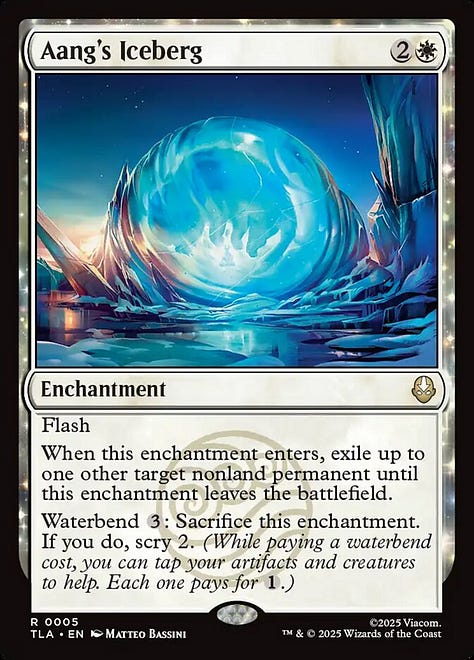
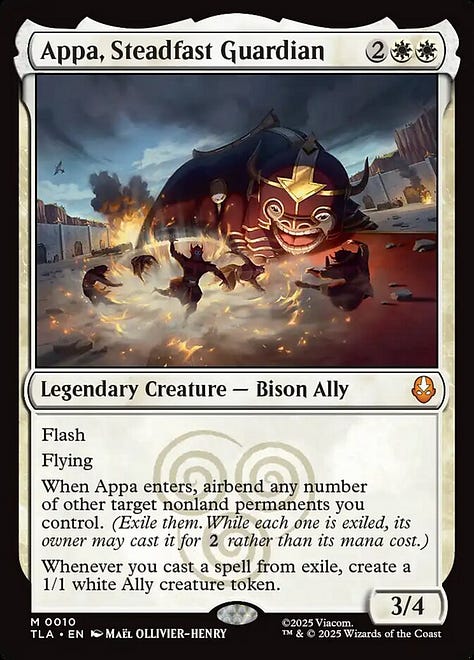
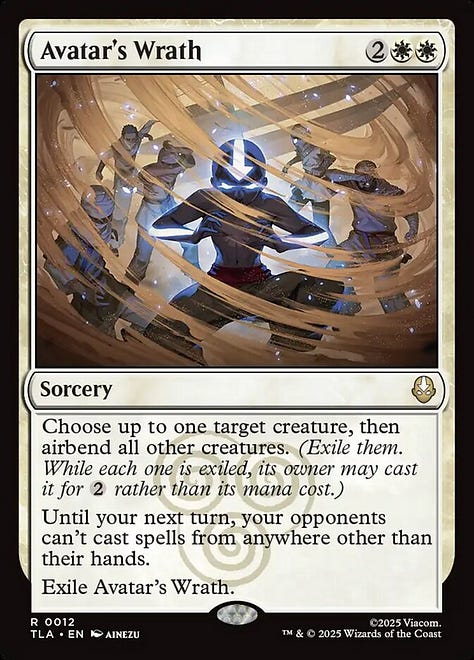
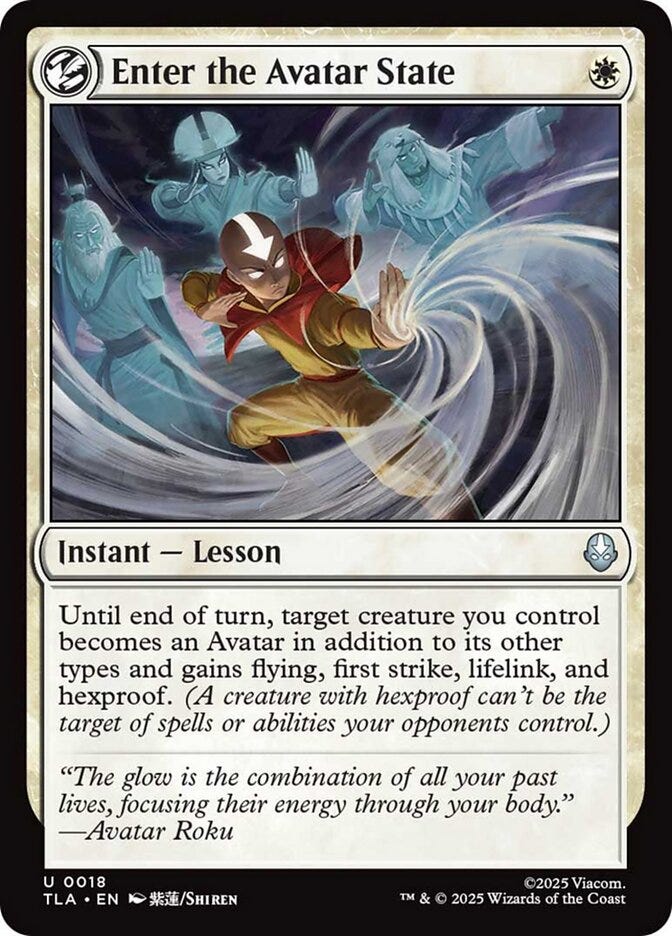
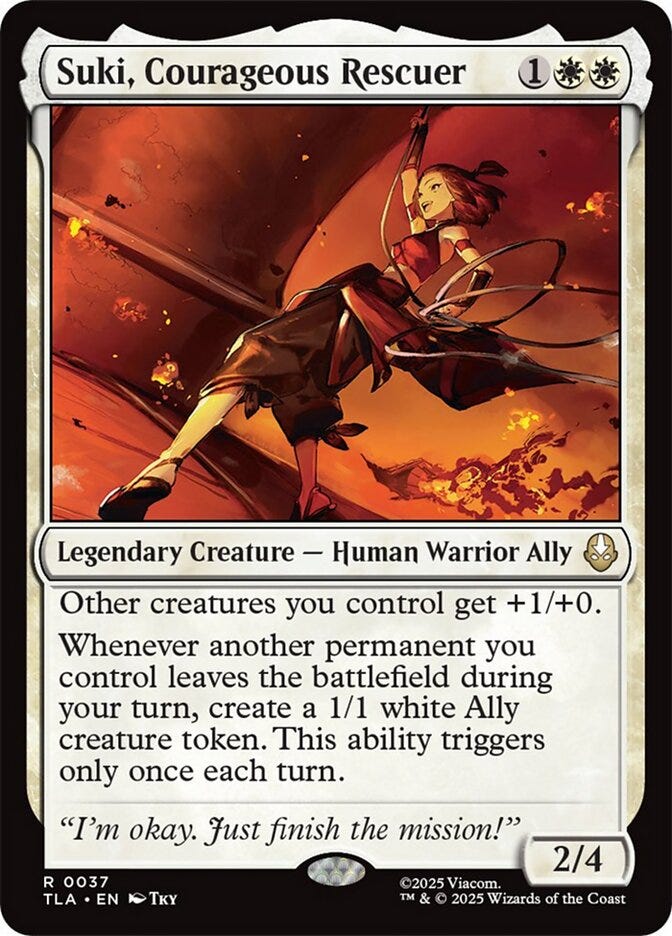

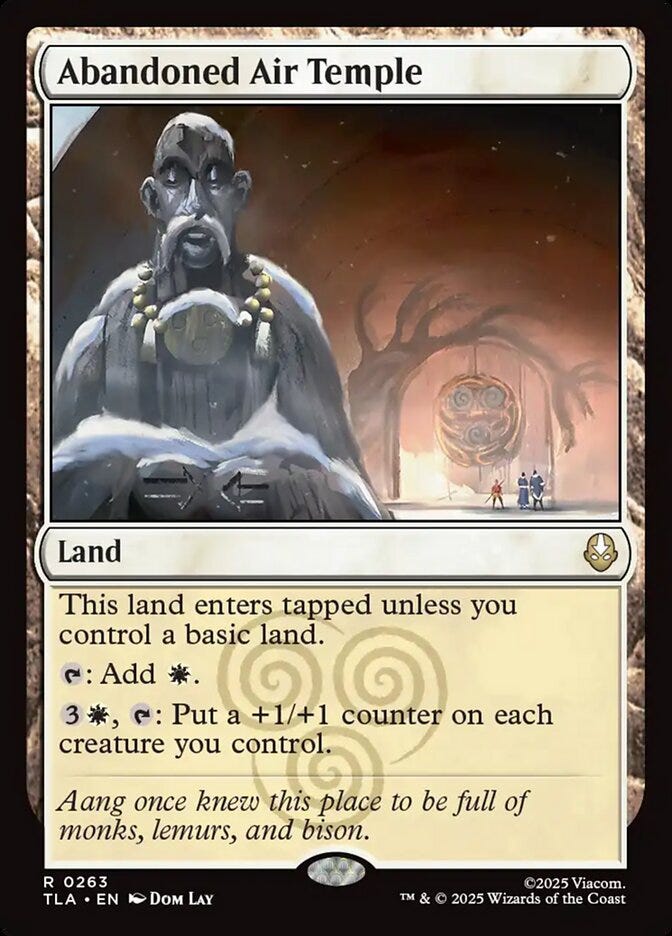
Power 4, Vibes 2.5
This performs well in decks with armies to pump and is also serviceable in the late game when you have nothing better to do, serving as a threat-of-activation to make blocking awkward for opponents or just being a mass-pump effect like Ouroboroid or United Front, which I’ll talk about later.
Gavony Township saw light cube play as a green-white utility land, but its lack of restriction to two-color archetypes helps it sneak into more maindecks. The fact that it’s not always untapped could incentivize drafters to avoid greedy mana bases, though that’s unlikely in practice since prioritizing nonbasic lands is usually correct even when strong options like this exist. As a white utility land, it’s among the more mana-efficient choices; others such as Cave of the Frost Dragon and Kor Haven felt clunky for their costs, which isn’t something that I feel with Abandoned Air Temple.
Power 3.75, Vibes 4
I’m cautiously optimistic about this card because it lets you break the symmetry in several ways: you can choose what stays on the battlefield, and you prevent the opponent from deploying new threats on the following turn. It’s not a true wrath, but for decks trying to survive, that’s often good enough. For decks that can use Airbending effectively, it serves as a workaround that doubles as a wrath-like effect
Power 3.5, Vibes 4
Oblivion Rings used to be cube staples, but over time their status as a three-mana sorcery answer has left them behind; more efficient answers like Council’s Judgement became preferred because they handle hard-to-kill permanents such as True-Name Nemesis. While this is mana-inefficient, flash helped offset that inefficiency by allowing instant-speed interaction, especially since the going rate for O-Rings with flash is usually four mana. The iceberg’s 3-mana cost made it questionable in aggressive decks, but it still showed up in those shells occasionally due to its effectiveness.
At first I thought the ability to crack the Iceberg wouldn’t come up often, but it proved live several times in testing. It was surprisingly easy to reach a point where you could crack one on the end step when the exiled threat no longer mattered. Being able to tap idle creatures or artifacts to pay the three-mana tax made the cost far more palatable.
Power 3.5, Vibes 4.5
Another flash + flying threat in the vein of Restoration Angel and Salvation Swan. Like Restoration Angel, airbending something away at instant speed in response to removal feels excellent. A 3/4 with flash for 4 mana isn’t as pushed as Resto was when first printed, but it’s still very effective for ambushing attackers or surprising blockers.
Gaining an ally usually helps offset the airbending cost, and tucking the creature away to airbend it back later isn’t a strict downgrade. That interaction shines against mass removal, when you don’t want to blink a creature only for it to die, or when you want to reuse the creature’s enter-the-battlefield effect, such as airbending a Snapcaster Mage to flash it back later.
Power 3.5, Vibes 3
White three-drops are stacked, which is partly why Suki is being overlooked as a “bad Adeline” They’re similar as both cost three, have four toughness, and create 1/1 creature tokens.
Both shine in the same kind of deck (white aggro that wants to go wide) but Suki’s mass-pump ability shouldn’t be underestimated. It provides sustained and burst damage and helps diversify threats beyond the single tall threat that Adeline represents. Suki doesn’t generate tokens as easily as Adeline, but token production is more common than you might think with the cards mentioned earlier in this article, and chump-attacking with Suki’s 1/1s is a viable route to generate tokens.
Power 3.5, Vibes 3
When I look at cards like these, I start by asking what a reasonable base rate is. Traditionally, x = 3 has been treated as the floor, since that translates to about six power for five mana, akin to Finale of Glory trading vigilance on the tokens while pumping your team. Mass pump lowers the practical floor significantly, which is part of why this card is being underrated: its baseline of functioning as a mass pump for WW or as an effective 1WW 2/2 that buffs your team are both solid outcomes, even if they’ll be the minority of cases. The concern that mass-pump isn’t good for cube is valid but not decisive.
We’ve already seen cards such as Ouroboroid, Heartfire Hero and Gau, Feral Youth care about their power, and incidental ways to increase that power make those cards better while leaving them solid on their own.
Power 3-4, Vibes 4.5
This card is mediocre on its own but becomes much stronger as a sideboard “oops, I win” button you can fetch with a Learn card. Giving something flying or enough life to stabilize is valuable, and not occupying a main-deck slot reduces the chance of it being a dead draw.
A weakness is that combat tricks that don’t change stats often underperform (first strike only helps when creatures have similar stats) so my expectations are modest. Still, this is one of the better targets for Learn packages, especially if the next Strixhaven set adds 2025-era power level creatures with Learn.
Blue:
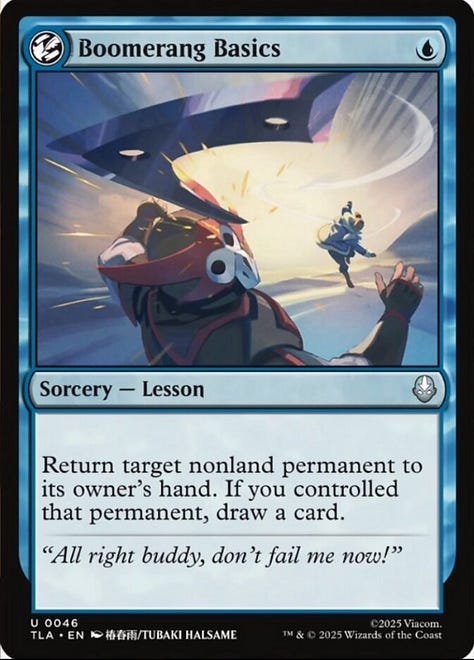
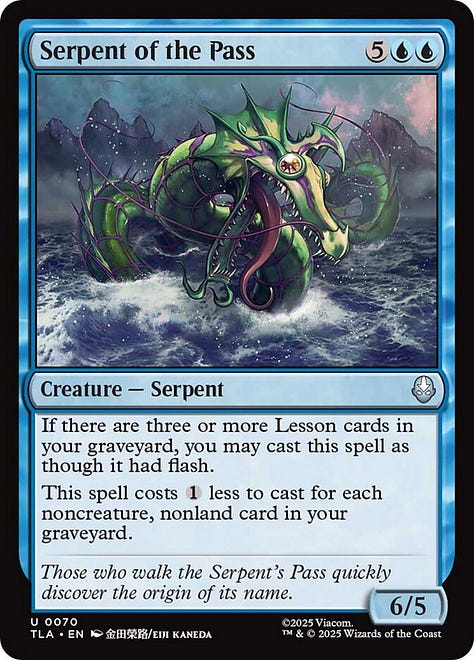

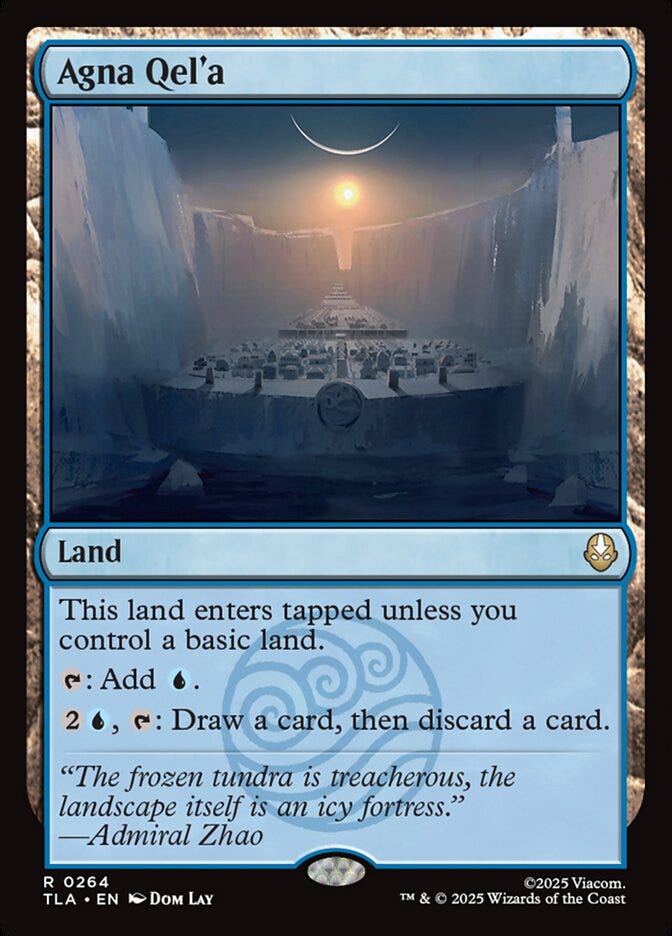
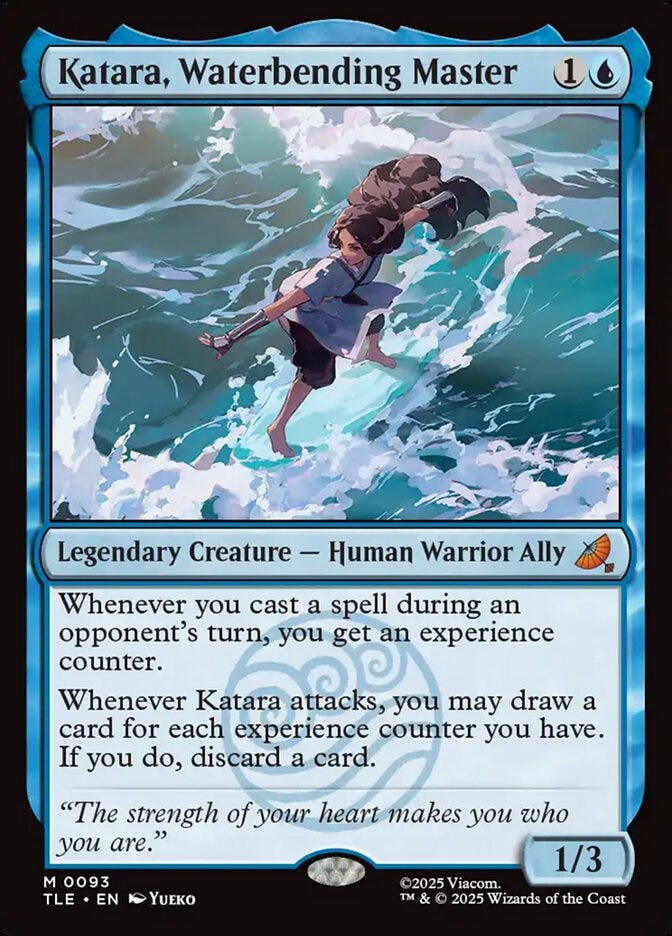

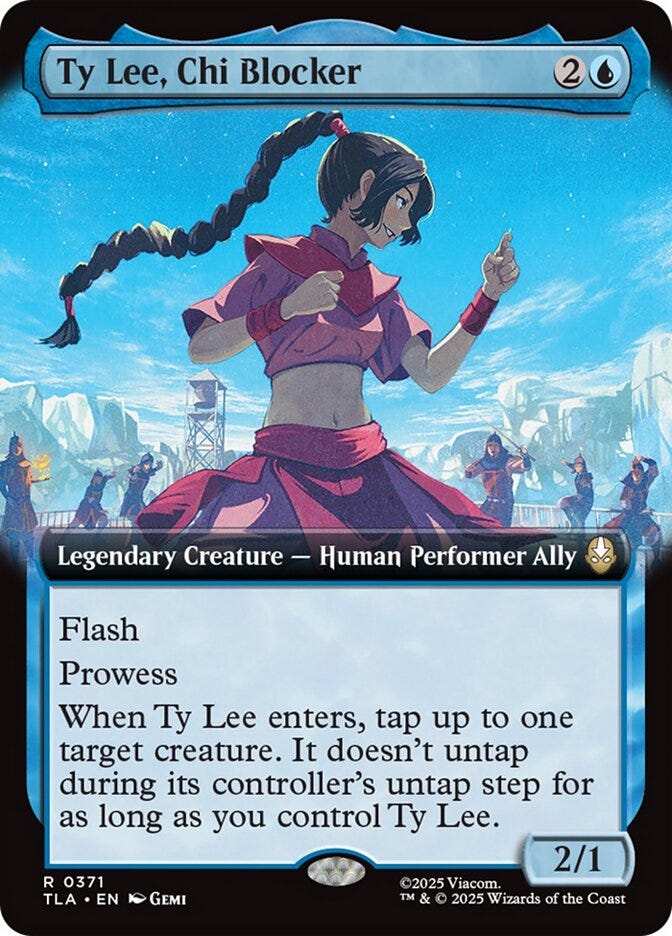
Power 4.5, Vibes 4
The natural comparison is Hydroid Krasis: both are big mana plays that draw cards, but Wan Shi Tong plays very differently because it has flash instead of gaining you life.
It’s not embarrassing to cast for X=1 or 2 mana, similar to United Front, since it still leaves a useful body on the battlefield. Hosing tutors and fetchlands is a nice bonus, but its base rate should be strong enough on its own; unlike cards such as Archivist of Oghma, which could be painfully weak when they didn’t immediately get you something, Wan Shi Tong rarely feels useless.
Power 4, Vibes 4
Tucking a threat and creating 6 power of flying for 5 mana feels more like a white effect than a blue one, which gives this card extra appeal since it doesn’t just bounce an opponent’s threat, it actually deals with it, even if only temporarily. The evasive tokens are useful for pressuring planeswalkers and for grabbing monarch/initiative, even though they’re poor blockers. While Wan Shi Tong’s token-generation is mostly flavor text in cube, I like how it helps blue decks handle problematic permanents and stands on its own as a real threat.
Power 3.5, Vibes 4
This flash creature is one of the few Dungeon Geists-style iterations that immobilizes a threat. As a flash card with prowess, it can produce combat blowouts, but it will most often be used to lock something down for a turn in combat, like Floodpits Drowner.
I like how well it turns the corner by using flash to neutralize a problem creature. My only concern is its base-body quality since without a prowess buff it dies to a stiff wind. That said, I’m cautiously optimistic it will perform well enough in blue tempo decks.
Power 3-4, Vibes 3.5
This plays similarly to traditional looters, but it requires more setup: you need to cast spells on an opponent’s turn and keep the creature alive during combat so it can attack multiple times, which creates both challenges and opportunities.
Because its experience gain isn’t limited to once per turn, you can advance it cheaply with instant-speed cantrips and interaction, though that isn’t realistic on turn two. In testing I found it underwhelming in decks that desperately wanted early graveyard access and relied on its looter floor, but it showed strong upside in decks that could reliably get it to two or more experience counters: blue-red and some blue-white builds did this easily. As with cards like Ouroboroid and The Endstone, a weak floor doesn’t make it bad if the average case and ceilings are high.
Is the ceiling worth it? Given how cheaply it can become a virtual Ophidian or better, I think so.
Power 3.5, Vibes 3.5
Like the white utility land, this land echoes a familiar card: Desolate Lighthouse. Loothouse, like Gavony Township, was a solid inclusion in decks but often got cut from cubes because it occupied a multicolor slot and had to compete with cards like Electrolyze.
Its lack of color-pair restrictions is a big plus, similar to Abandoned Air Temple. While blue has some highly color-aligned lands (for example, Shelldock Isle), I wouldn’t hesitate to play Loothouse in a blue deck, it pairs exceptionally well with instants and flash, letting you do something useful when you don’t have anything else to do or anything to counter. Cube designers may find some difficulty, but cube sections don’t need strict symmetry in color alignment anyway.
The real question is whether this Loothouse will make blue decks better and increase drafters’ enjoyment.
Power 2.5-3.5, Vibes 3
As a standalone card, I’m not very excited about this sorcery-speed bounce, except in environments where it dodges graveyard hate like Rest in Peace by bouncing your own permanents for maximum value. Despite Into the Flood Maw and This Town Ain’t Big Enough performing better than expected, the sorcery speed severely limits this card’s utility.
Its ceiling is much higher as part of a Learn package, where it can meaningfully interact with a wide range of threats. In the maindeck, however, I’m much less enthusiastic about it.
Power 2.5, Vibes 1.5
This is another Tolarian Terror–style card, but one that cares about a wider range of permanents, including noncreature and nonland cards. The Lesson text reads like flavor text, but it could become relevant if future Strixhaven sets add more Lessons.
Black:
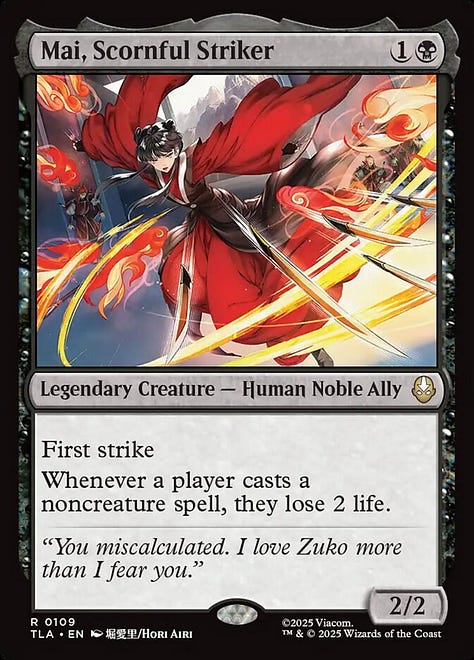
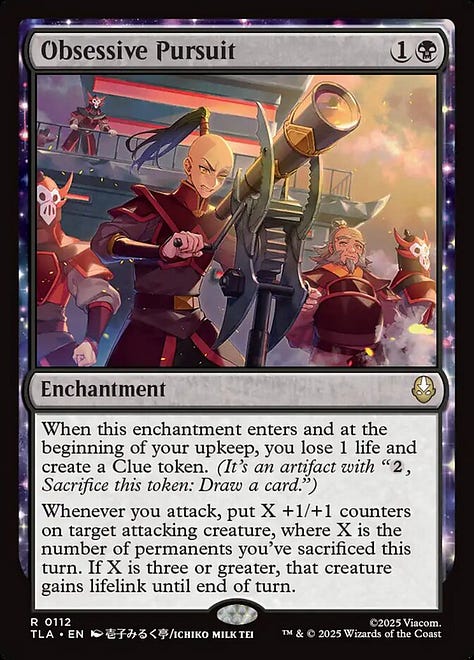
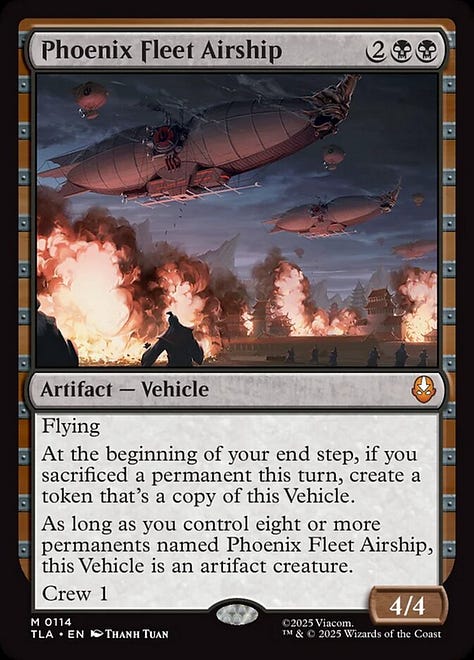

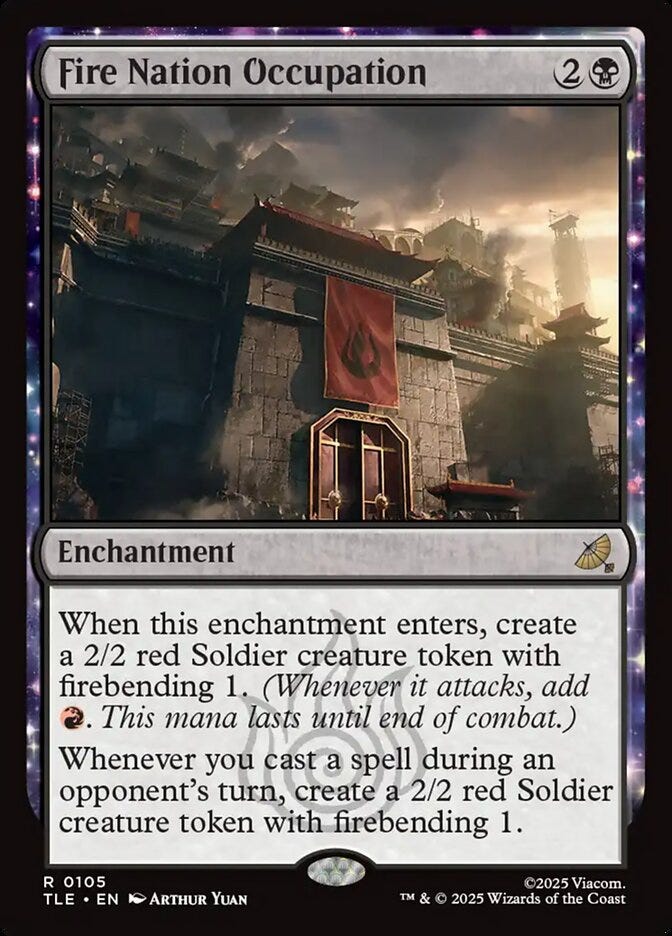
Power 4.25, Vibes 4
The floor of getting a Gray Ogre with Firebending isn’t terrible, but it’s not great either, since the baseline rate is about two mana. It doesn’t take long, however, for this card to show strong ROI: chaining it into a cantrip, a flash threat, or cheap interaction on the opponent’s turn is a very good payoff for proactively grabbing cards to cast off-turn.
Not being limited to once per turn is a big plus, and triggering on cast (even if the spell is later countered) matters a lot in instant-speed matchups, as casting something on the opponent’s turn still gives you a 2/2, even if they can counter the spell.
Power 4, Vibes 2.5
I’ve heard this called a black Thalia, but black Eidolon of the Great Revel is a closer comparison: it’s primarily a card for aggressive black decks. Although its damage ability is symmetrical, aggressive decks care less about paying life, much like with Eidolon. It’s a solid clock that punishes opponents who can’t deal with it; even if it dies to a Shock, it will often have already paid for itself by dealing damage back to the opponent. In practice it usually deals more damage to your opponent than to you.
First strike helps in evenly matched creature combat, but this is likely one of the first cards to sideboard out in the aggro mirror. That’s fine, that’s what the sideboard is for!
Power 3.75, Vibes 4.5
We’ve seen a few 3/3s for 3 that hate on the graveyard with Lord Skitter and Graveyard Trespasser being obvious comparisons, and it was always nice that their graveyard-hosing thing so without requiring extra mana. I generally preferred Graveyard Trespasser, even with its day/night nonsense, but this new riff mostly does what those cards do.
The drain ability is a useful bonus when you can get Clues from it, though it will more often be extra value when you crack those Clues. This version is also unique because it draws a card when it reanimates a creature from the graveyard; that card draw alone likely puts it ahead of the other two.
Power 3.5, Vibes 4
Somewhat like a Broodmate Dragon effect: it creates a couple of flying threats, but they must be crewed and you need something to sacrifice. Fetchland and Landscape stonks keep rising, and Phoenix Fleet Airship is another strong way to turn them into big mana — the question is how often that will happen consistently, since it’s terrible if the effect fails to duplicate.
Needing a four-mana investment to crew it before it has board presence is annoying, and the “eight copies” text feels mostly flavor text, but it’s nice that it doesn’t simply die to creature removal.
Power 2.5-4, Vibes 3
Of all the cards in the set, this one puzzles me the most in terms of how strong it is. I’ve seen comparisons to Proft’s, and I can see the similarities, although it doesn’t accumulate counters as explosively as Proft’s does.
My initial read is that it’s either quite good or completely unplayable, and making a clue when it enters helps raise its floor. Daxerz also pointed out that it’s valuable as a clue generator that provides its own payoff for sacrifice synergies, similar to Legion Extruder, Gut, and cards like Nettlecyst that care about the cardboard.
Red:
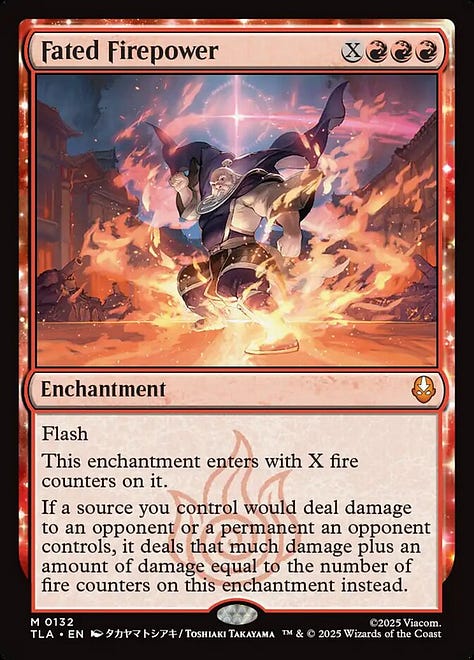


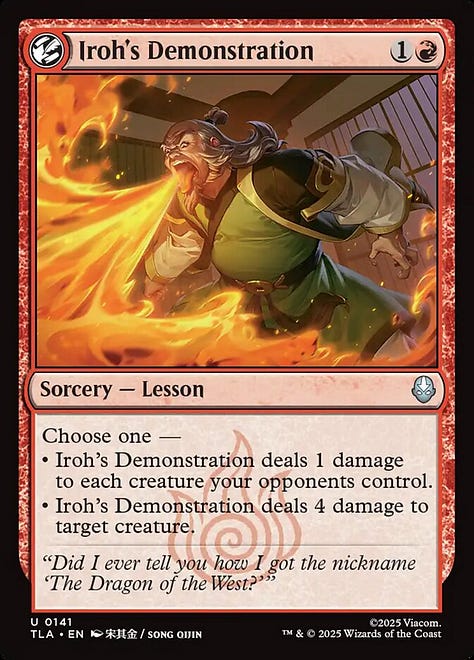
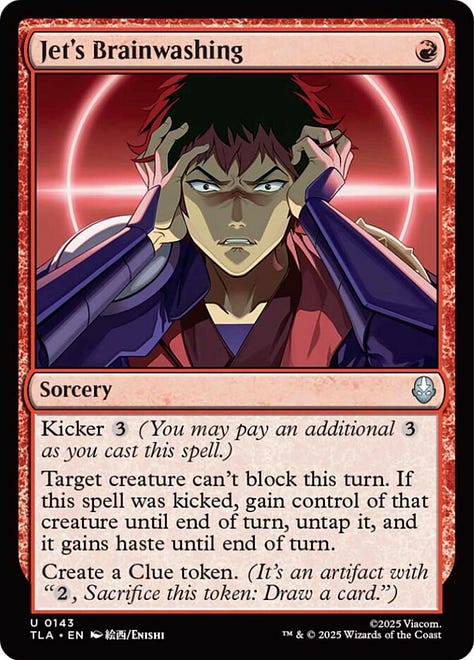
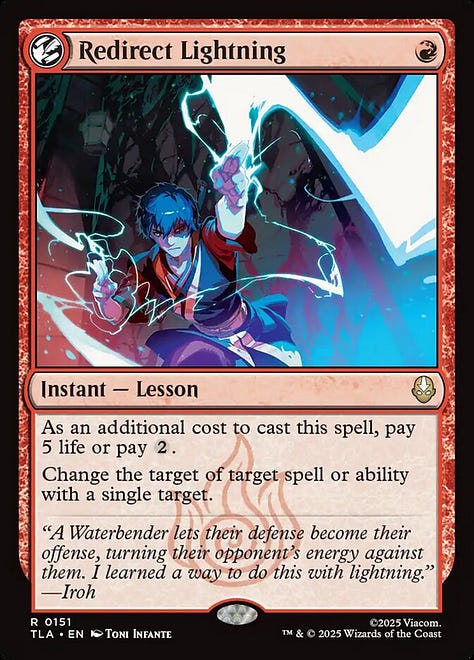
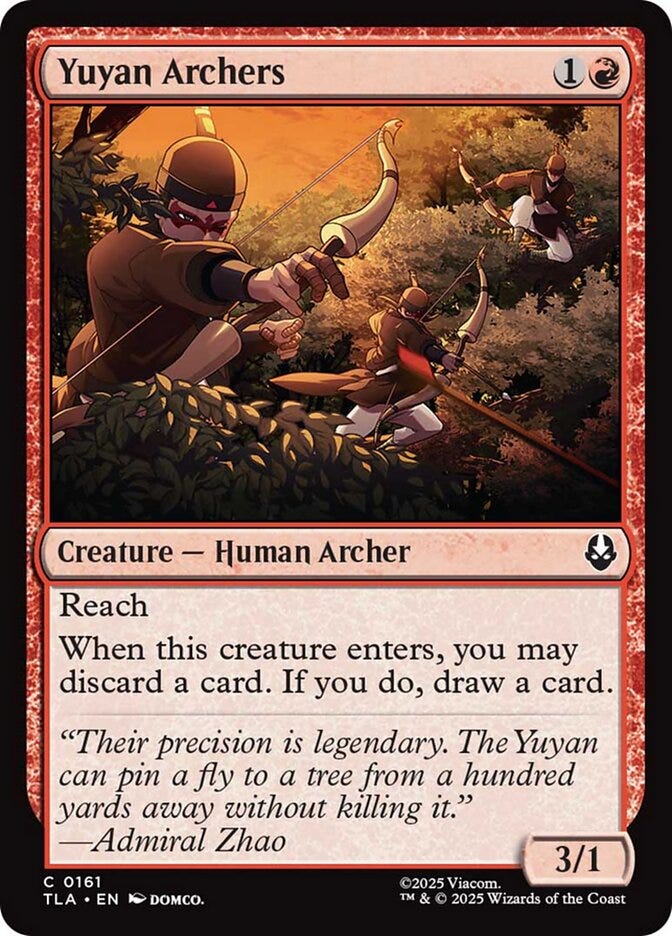

Power 4-4.5, Vibes 4
Generally, redirect effects like this don’t work well in cube, partly because they usually cost several mana. When I tried this card, I was surprised how often it was live: it can redirect activated and triggered abilities, which is great against creatures with ETB triggers that target something.
The option to pay life is similar to the Phyrexian mode on Dismember, as it lets you represent the ability with R but gives you a buyout of 2R if you have the mana.
This is another case where access from the sideboard is extremely useful, especially at instant speed via Divide by Zero or Academic Dispute. Red aggro decks might not want it in their maindeck, but they wouldn’t refuse having it available as a surprise answer.
Power 4-4.25, Vibes 3
This card reminds me of Vivi as it punches well above its mana cost (Tifa feels similar, though she needs less help to reach that level). Without buffs, she won’t generate a mana advantage, but cards that can reliably recover their mana investment usually perform well in cube.
Even unbuffed, she makes a mana on attack, which often funds an instant-speed effect to boost her power. That potential should be enough: early-game aggro wants to spend resources proactively, and she helps enable that plan.
Buffing raises her ceiling but isn’t required. I rate her higher for decks that can consistently push her to attack for 2–3 damage.
Power 3-4.5, Vibes 1.5
We’ve seen plenty of four-damage spells for cube, but this one’s flexibility to clear armies of tokens and small creatures is a valuable upside for an on-rate removal. Getting it from a Learn card is especially attractive, having a real removal effect available in addition to the card’s other value is a big plus.
Power 3.5, Vibes 4
This reminds me of Dictate of Heliod, a card I liked in Journey to Nyx as an absurd combat trick, but which struggled to fit into aggressive decks because of its five-mana cost. I want to like this one: thanks to flash, it can represent lots of damage whether played at the end of turn or during combat. If you already have a pile of burn in hand or a decent board, putting this into play can end the game.
I don’t think it’s purely a “win more” card, but the fact that it does nothing on its own is a legitimate concern. Still, I wouldn’t be surprised if it performs better than expected, casting it for five and blowing the opponent out is a real possibility.
Power 3, Vibes 3
Setting aside the land-transform text, this functions like a symmetrical big Thalia for lands, a disruptive two-mana 2/2 with menace that can punish opponents who rely on nonbasic lands or big interaction. Non-basics entering tapped provides just enough disruption to interfere with an opponent’s wrath or other answers. Like Mai, the decks that want this card often don’t mind being affected by its ability.
I prioritize lands highly when drafting, partly because the punishments for greedy mana bases are limited (Price of Progress is a hamfisted solution.) Cards like this make me think twice about hoarding every land pick, though honestly it probably won’t stop me or other greedy drafters from doing the same.
Power 2.5, Vibes 4
I’m curious about this card as a fit for Boros aggro alongside Hired Claw, Jacked Rabbit, Smuggler’s Copter and Glorybringer. It’s probably not “good enough” on its own, but I wouldn’t be surprised if it gets there. Making a 2/2 for 2 is a low ceiling, but it’s an acceptable floor which usually is enough to get there.
Power 2.5, Vibes 2
I usually don’t value Threaten effects in cube because they mostly serve to finish off an opponent, but the modality on this card makes it more useful than it first appears. You can “evoke” it for R to make a creature unable to block, and getting a Clue for your trouble helps when you’re digging for threats.
My usual test is “is this better than a burn spell?” For noncreature red cards like Cori-Steel Cutter, the answer has often been yes. For this card, though, the answer is probably no.
Power 2, Vibes 2.5
I don’t often call out role-filler cards, but this one plays well as a two-mana way to put a creature into the graveyard, useful for reanimation or for a red deck with cards that care about discarding, while still presenting a 3-power threat.
Green:

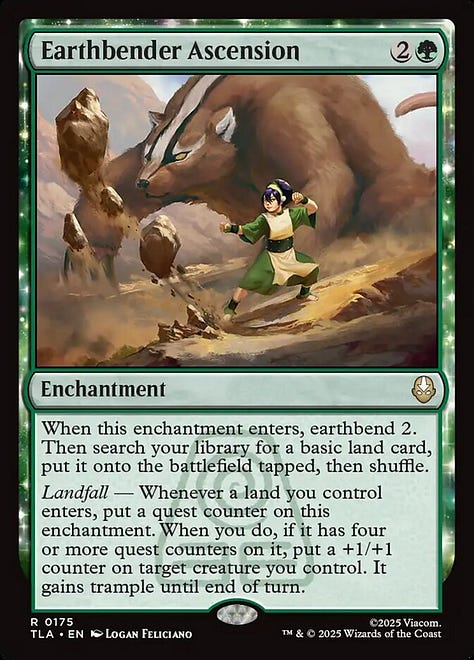
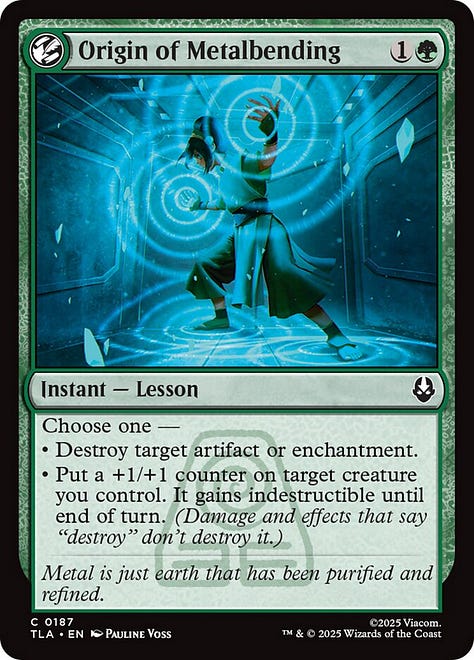
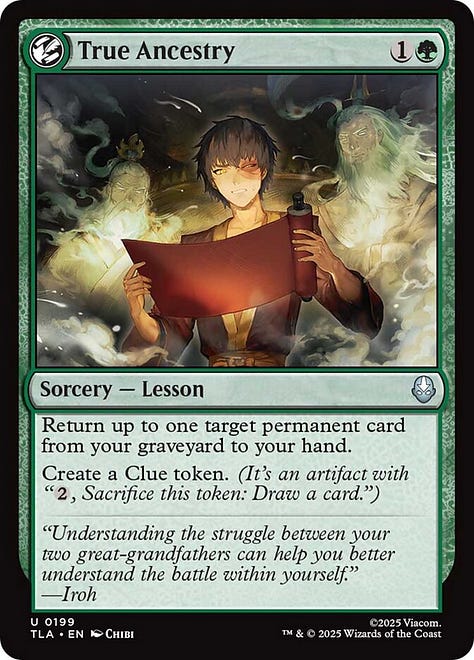
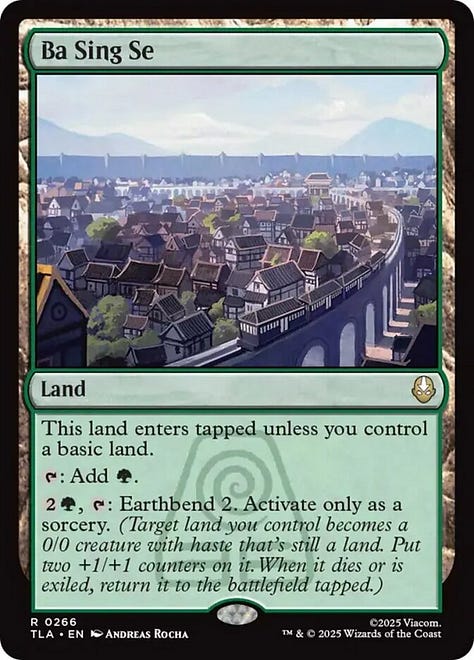
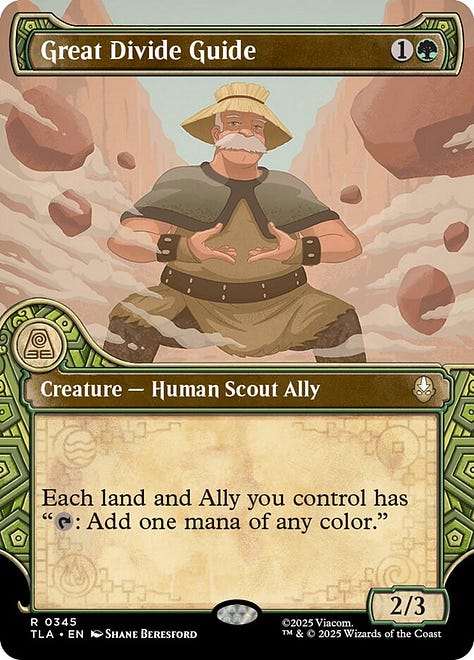
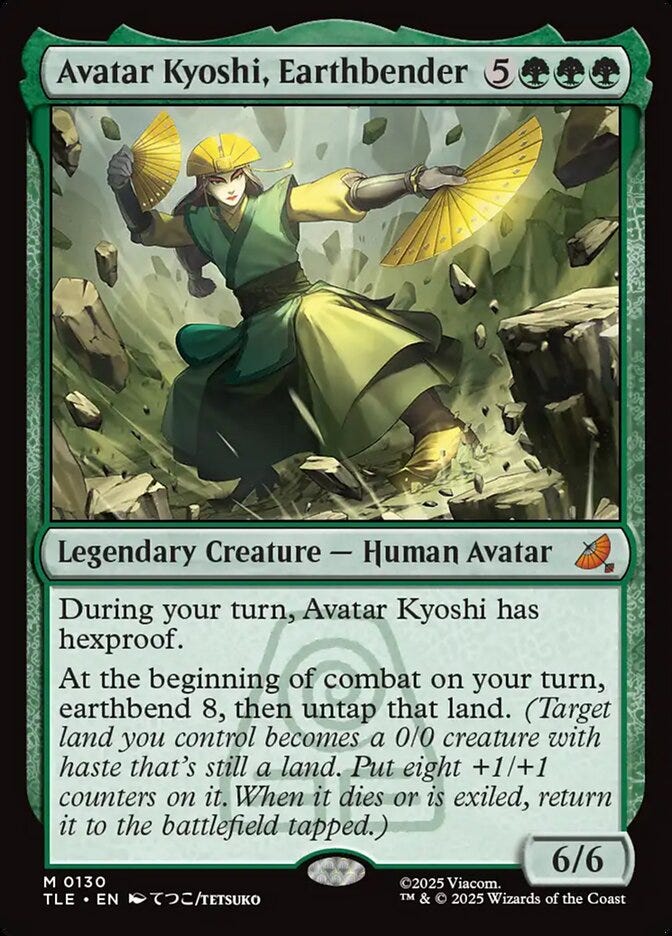

Badgermole Cub:
Power 4.5, Vibes 4
I’ve heard a lot of hype for this card, and it probably deserves it. It’s one of the cheapest ways to Earthbend in the set and pairs extremely well with other mana dorks. Like Firebending Student, it can punch well above its mana weight class, but even its floor, a 2/2 and a 1/1 for two mana, is solid. If it Earthbends a land that sacrifices itself, you get a huge payoff.
Power 4, Vibes 4
Sorcery speed makes me think this will underperform compared with instant-speed options, since it can’t play the same role as Fountainport or other instant-speed tricks. My read is that it simply forces you to be more careful with sequencing. Even at sorcery speed, it still does everything Earthbend does: you can double-dip with fetchlands and turn lands into something useful in the late game.
Power 3.75, Vibes 4.5
As a cheat target, a card works best when it has immediate impact, resilience to removal, and a fast clock to finish the game. Hexproof helps its resilience and increases the chances it can end the game quickly. I don’t think this replaces cards like Vaultborn Tyrant, but it likely supports them.
Power 2.5-4, Vibes 3.5
Like Enter the Avatar State, this is a card you’re not excited to maindeck, it’s essentially a Naturalize with upside, but it’s mana-inefficient in both roles by modern standards. It improves significantly as a sideboard option: mana inefficiency matters less when it’s an occasional answer you can bring in to destroy something problematic or use as a surprise combat trick.
Power 3.5-4, Vibes 4
Unlike Origin of Metalbending, this one is fine as a two-mana draw-two in practice, even if that’s stretching the definition. I haven’t tested it in my cube, but getting a fetchland plus a Clue for two mana is a solid rate. Nature’s Spiral effects often underperform in cube, so I’m unsure how often this belongs in the main deck versus the sideboard, but making a Clue pushes it toward maindeck play. It fits green midrange plans that grind with attrition and helps decks that care about Clue tokens. Overall, I’m cautiously optimistic.
Power 4, Vibes 4
This plays like a Sutina that can’t block when it’s first cast - a respectable cube card on its own - but it trades the land-bounce ability for a built-in Retreat to Kazandu that can also grant trample, which is great when your large landfall threats get chump-blocked. Because the effect is split between the animated land and the enchantment, you don’t lose everything if the 2/2 dies to a Shock: the land still animates and you can continue building toward Retreat to Kazandu.
Power 3.5, Vibes 4
Ally flavor text aside, this is one of the better rainbow mana fixers: a 2/3 for two that produces mana and makes your lands capable of generating rainbow mana. I prefer it to Sylvan Caryatid, despite Caryatid’s hexproof, because the ability to fuel very greedy mana bases often offsets the missing protection. A 2/3 isn’t a great attacker, but having that option is useful.
You could argue that turning all your lands into rainbow sources is overkill and leaves you vulnerable if the creature dies, but careful mana sequencing usually mitigates that risk. I’m unsure how Arena’s auto-tapper will handle it, though.
Power 2.5-3.5, Vibes 4
This one flew under my radar as a Curse of Predation variant, and it’s slightly better because it doesn’t require the creature to attack. Tapping mana elves and buffing creatures through crew or saddle is a nice upside, and it’s a solid way to put counters on things if that’s your plan.
Multicolor:
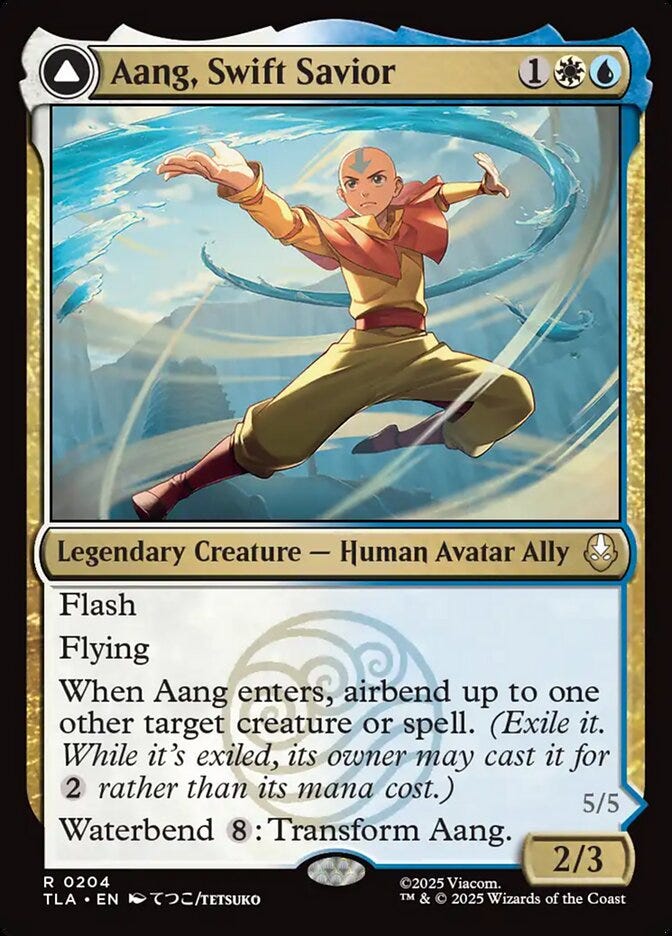
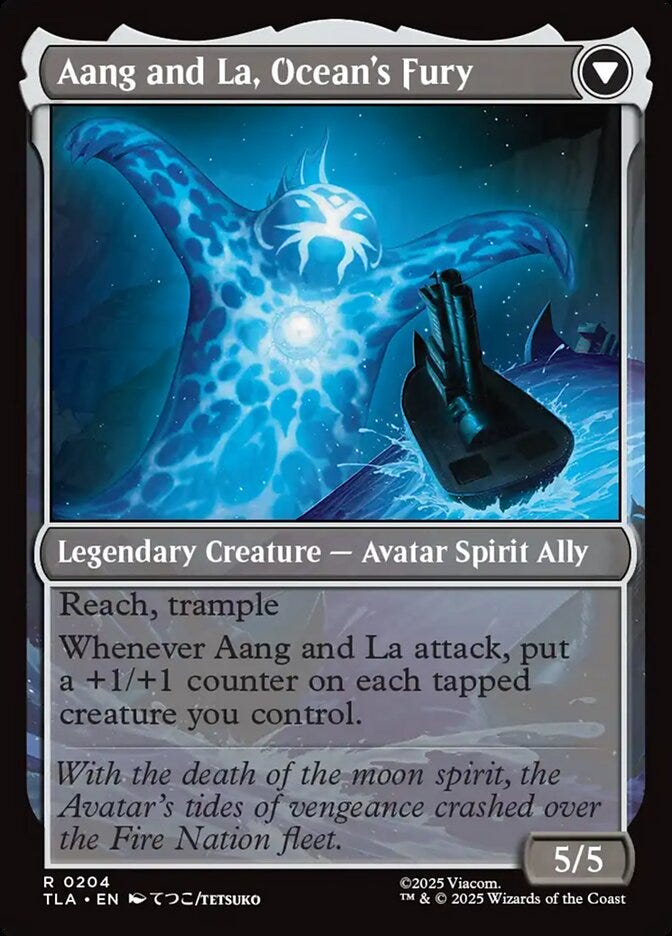
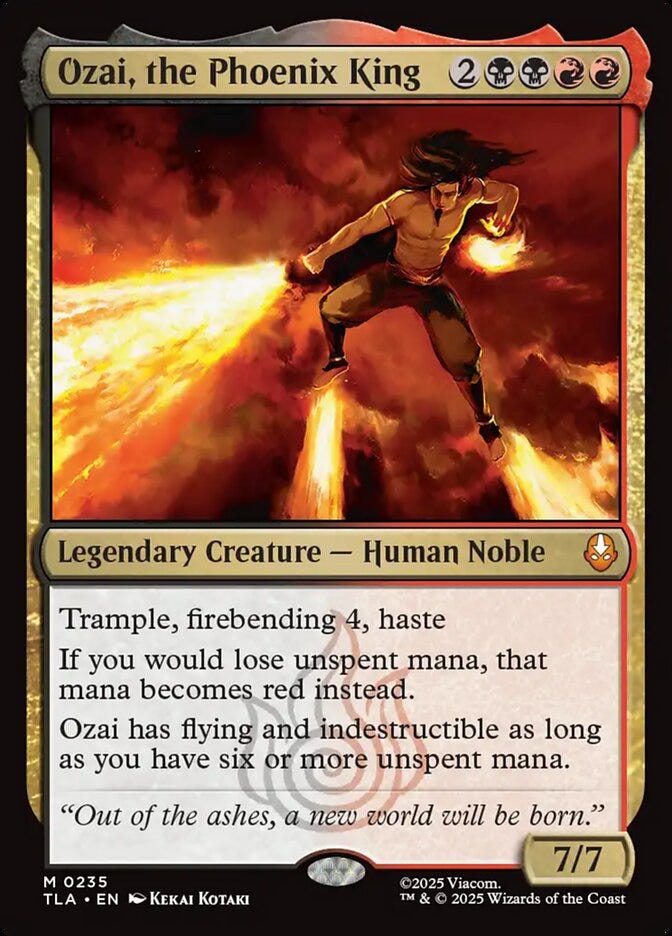
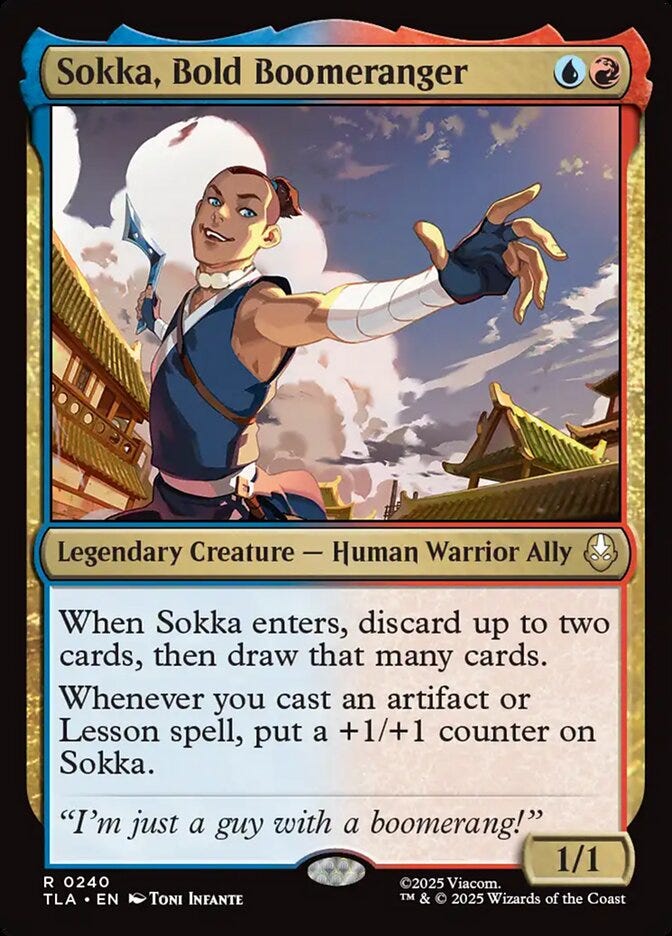
Power 4.5, Vibes 4.5
Thinking of this as Spell Queller meets Aven Interrupter gets you part of the way there, but the ability to airbend creatures makes it much stronger by letting it meaningfully impact the board. It can neutralize an opponent’s threats or, less commonly, support your own creatures, and being a 2/3 gives it enough presence to ambush 2/1s in combat. Waterbending also makes the eight‑mana activation less intimidating, so it becomes a credible late-game plan to help you turn the corner.
This card shines in blue‑white tempo builds that run a few creatures to justify Aang’s flip side and to benefit from the flipped form. Blue‑white has traditionally been a control color in cube, but with more aggressive archetypes around, this is a strong tool for pushing blue‑white into tempo and aggressive hybrid builds.
Power 3, Vibes 3.5
I don’t think this replaces the top-tier Izzet cards, but I like it as a cheap way to sculpt your hand and as a companion to red discard synergies or as an oddball way to dump cards into the graveyard. I haven’t seen it combo with artifacts like Basim Ibn Ishaq yet, but like Basim, its ceiling rises a lot if it can reliably become a 3/3 or larger.
Power 2, Vibes 3
This checks fewer boxes as a cheat target than others, it’s resistant to removal but doesn’t leave anything behind when it dies. It presents a solid clock and can be a titan-like 6‑mana finisher, but it depends on decks being able to use RRRR on attack. Overall, I don’t think it supports what red‑black wants.
Hybrid:
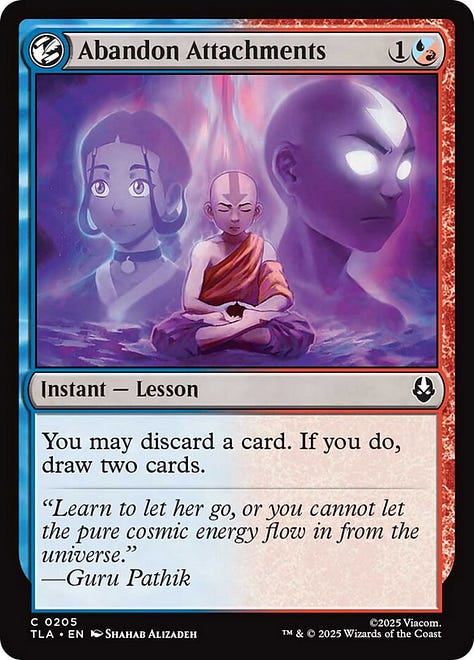

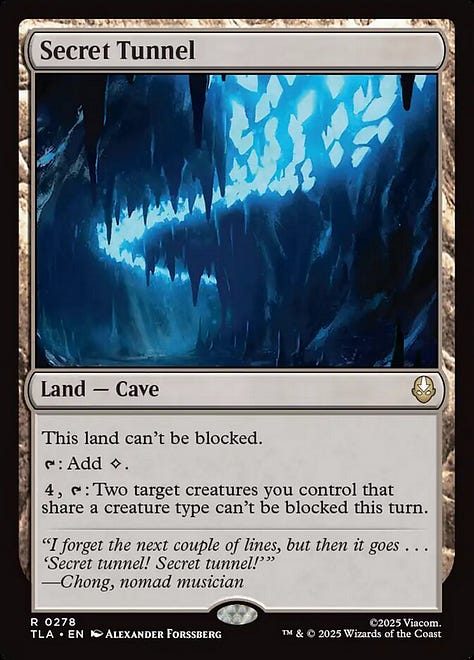
Power 3-4.25, Vibes 3
We’ve seen many discard-plus-draw-2 effects before, but having this at instant speed in Izzet makes it especially flexible for trimming unneeded cards and digging for answers. In my cube tests, even without leaning into Learn, it performed well as an instant-speed draw-two with a discard cost. Being a Learnable option is another plus: you can fetch it late to refill and get extra leverage from your Learn cards.
Professor Zei, Anthropologist:
Power 2.5, Vibes 3
A two-mana rummager that doesn’t cost mana to activate is unusual for red, and it’s useful that blue gets access to the effect as well. It helps discard-focused red decks, though needing the creature to survive to untap and acting as a rummage rather than a straight-up loot effect can be awkward. This feels more like an honorary red card than a pure Izzet one, but having the option to cash it in for an instant or sorcery is a handy late-game bail‑out, even at sorcery speed, as that utility matters when the creature’s value dwindles.
Artifacts/Colorless:
Power 1, Vibes 4.5
I’m mainly mentioning this so that you don’t make the same mistake that I did - this requires 2 matching targets to work, making it significantly worse than something like Access Tunnel.
Thanks for reading! You can find my socials and my cube lists on my Linktree, as well as other cube set review articles and design articles that I’ve written over the last 15 years.
*Since the Aetherdrift review, two scales were used for rating cards: power and vibes. Some recent examples:
Fuel the Flames: Power: 3, Vibes: 1
Daretti, Rocketeer Engineer: Power: 1, Vibes: 4
Opera Love Song: Power: 4.5, Vibes: 3
The Endstone: Power 3-4, Vibes 5:
Universes Beyond changes the equation for vibes, and while I’m only vaguely familiar with the Spider-Man universe through nerd culture and I’m not averse to Universes Beyond, I’ll leave it to you to determine how much of a factor that is for your cube’s vibe.
Inspired by Scuffle D. Lux’s set reviews, I’m noting a power level band for some cards, since some are highly contextual and it’s about time that reviews do that more often using the “floor” as the average cube case with the higher number being its ceiling.



Wan Shi Tong, Librarian moves me closer and closer to all flash creatures in blue. That and the cub will keep me busy at 360 for sure and enough other interesting mechanics to call it a solid cube set. Not everything can be EoE or a horizons set but I would be exhausted if they were.